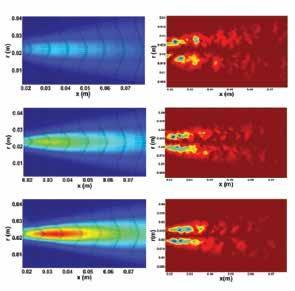
‘High-resolution and non-intrusive’ experimental measurements are indispensible for study of complex fluid flows that are frequently encountered in industrial and environmental situations. In today’s age and technology, it is possible to do so with the help of laser-based optical imaging. Our research focuses on using non-intrusive techniques to study instabilities, mixing, and turbulence in complex flows by capturing a spectrum of length-scales ranging from micrometer to centimeter. This ensures that both large-and small-scale flow features are resolved with considerable accuracy.
Two such instances are shown in the images above. Particle image velocimetry (PIV) and Laser induced fluorescence (LIF) were used to capture the intricate features, such as the potential core of a free jet (Fig. 1) and interfacial instabilities (Fig. 2), in complex fluid flows.
Fig. 1 shows a heated pressurised horizontal jet emanating into ambient conditions. The velocityand vorticity dynamics were captured using PIVtechnique. The downstream velocity profile in conjunction with turbulence characterisation is crucial for modeling free jet flows, which are encountered in many engineering applications ranging from spray combustors to fluidsed bed systems.
Fig. 2 shows a typical shear-driven mixing process, between a cold and a hot fluid, captured using LIF technique. The mixing dynamics and nature of turbulence under such circumstances are important for tackling many industrial and environmental problems such as cooling technology, cloud processes, and fluid intrusions. The primary research focus is on setting up of controlled laboratory experiments, recording high fidelity data using non-intrusive techniques, and extracting quantitative statistics on flow dynamics using post-processing softwares.
Prof. Sridhar Balasubramanian
